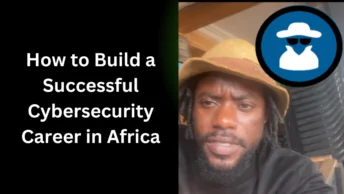Good evening/morning! I received an interesting question from a fellow cyber security enthusiast who is eager to dive into the world of Open Source Intelligence (OSINT).
It’s a path I’ve walked myself, and I’m excited to share insights on how you can start your OSINT journey—whether you’re looking for formal training or prefer the self-taught route.
What is OSINT? Open Source Intelligence (OSINT) refers to gathering and analyzing publicly available information to help solve cases, conduct investigations, and even prevent cybercrimes.’
It’s a crucial aspect of cyber security, intelligence, and law enforcement. From tracking malicious actors to identifying threats, OSINT allows you to extract valuable insights from online sources—like social media, forums, public databases, and more.
If you have a passion for solving cases, especially in the cyber world, OSINT is a great way to contribute and help people while making a real difference.
How to Start Your OSINT Career: Formal Education vs. Self-Learning When it comes to getting into OSINT, you can either go the formal route (through institutions) or embrace self-learning. Let’s break it down:
Formal Education: OSINT Courses and Certifications If you prefer structured learning and a credential to back it up, enrolling in an OSINT course or pursuing certifications could be beneficial.
Some institutions and platforms to consider are: SANS Institute: Offers excellent courses such as FOR578: Cyber Threat Intelligence and SEC487: Open-Source Intelligence (OSINT) Gathering and Analysis.
These provide hands-on training and deep insights into OSINT practices. The SANS courses are known for their rigor and relevance in the field of cyber security.
The Cyber Intelligence Tradecraft Certification (CITC): Provided by McAfee Institute, this certification covers OSINT methodologies and intelligence gathering techniques for cyber investigations.
Cybint: This platform offers Cyber Intelligence & OSINT training that’s practical and beginner-friendly. It’s a great place to start if you’re looking for foundational knowledge.
Udemy and Coursera: Both platforms have various OSINT-related courses. While these are less formal than SANS or McAfee, they offer flexible, affordable options for learning specific OSINT tools and techniques.
These institutions offer recognized credentials, making them ideal if you plan to pursue a role in government, law enforcement, or a large organization.
Self-Learning: The OSINT Path to Mastery If you prefer self-paced learning like I have done all these while , you’ll find plenty of free resources and tools online to start your OSINT journey.
Here’s how you can break it down: A. Learn the Basics of OSINT Start by familiarizing yourself with what OSINT is, its applications, and the ethical considerations involved.
Some resources to begin with: The OSINT Framework: This is an extensive collection of OSINT tools and techniques, categorized by different uses (e.g., social media analysis, domain research). It’s an excellent roadmap for beginners.
https://sector035.nl/articles/category:week-in-osintOSINT At Home (by Sector035): This weekly newsletter shares real-life OSINT cases and challenges, helping you understand how OSINT is applied in the field.
B. Master OSINT Tools The tools you use in OSINT will be key to your success. Here are some must-learn tools: Maltego: A powerful data visualization tool that helps you map and analyze relationships between people, companies, domains, and more.
Google Dorking: Learning advanced Google search techniques is essential. It allows you to dig deeper into publicly available information that others might overlook.
SpiderFoot: An automated OSINT reconnaissance tool for gathering information on IP addresses, domains, emails, and more. TheHarvester: A tool to gather emails, subdomains, hosts, employee names, and more from public sources.
C. Engage in OSINT Communities Joining communities can fast-track your learning. Twitter now X, for example, is full of OSINT enthusiasts and professionals sharing tips and real-world cases. Follow people like
or check out the subreddit r/OSINT. Participate in Capture the Flag (CTF) events and challenges to sharpen your skills.
D. Hands-On Practice. The only way to master OSINT is through practical application.
Start by working on OSINT challenges from platforms like: Trace Labs: They host OSINT Capture the Flag events focused on helping law enforcement find missing persons.
This gives you the chance to practice OSINT while contributing to real-world investigations. IntelTechniques: This site offers free OSINT training modules and techniques. You can practice in real-time using their resources.
3.Building Your Career in OSINT. Once you have a solid foundation, you can start thinking about how to build a career. Here are some tips: Start a Blog or Portfolio: As an OSINT expert, showcasing your work is important.
Start documenting cases, investigations, or techniques you’ve mastered. Potential employers will appreciate seeing practical examples of your skills. Certifications Matter: While self-learning can get you far, formal certifications like the ones mentioned earlier (SANS, McAfee) will help solidify your expertise and make you stand out. Network in Cybersecurity Circles: Attend cyber security conferences, join online forums, and keep connecting with people in the field. Networking plays a huge role in landing opportunities in OSINT.
Starting a career in OSINT can seem daunting, but with the right approach, it’s achievable. Whether you choose formal education or self-learning, the key is to stay consistent, practice your skills, and engage with the community. OSINT is a powerful tool in solving cybercrimes, and by taking this path, you’ll not only help others but also contribute to a safer digital world.
Stay focused, keep learning, and welcome to the world of OSINT!
If you’re interested in more detailed guides or specific OSINT techniques, don’t forget to subscribe to my blog at pope
http://popelucas.com and follow me (113) Pope Lucas – YouTube for regular updates on OSINT tools, tips, and case studies. Let’s embark on this journey together!







